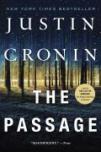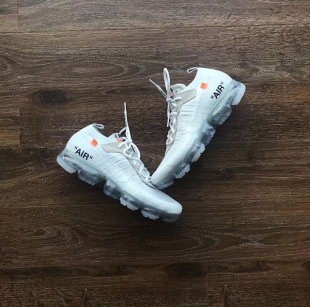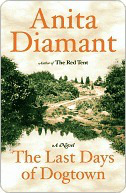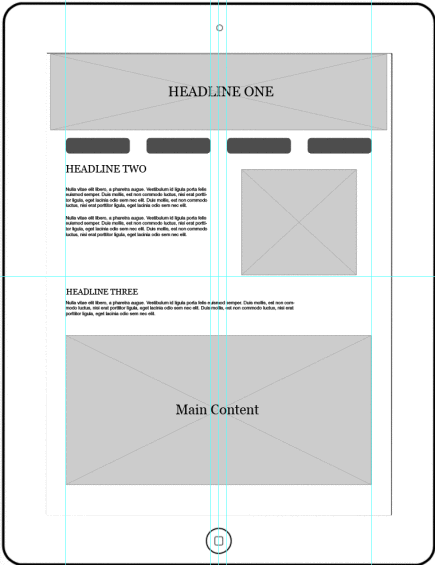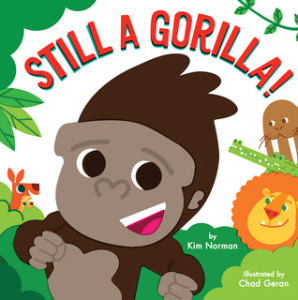I’ve always been a bit of an adventure seeker. Growing up you’d sooner find me barreling through forests on horseback at full speed, as opposed to playing with dolls. Or I’d go get lost with my dog in the corn fields behind my house for a few hours instead of watching TV. My parents hung a loud farm bell that could be heard for a mile in any direction when it rung. As long as I was home within 15 minutes of that bell ringing, I was free to adventure anywhere within ear shot.
I mean, who would pull up roots to live on a small island in the middle of the Eastern Caribbean for 3 years for school, without visiting the island prior to the move, and without knowing a single soul there?
Me. That’s who. When else was I going to get the opportunity to experience life outside of the US?
Given the way that I approach life, it should come as no surprise that with respect to racing, the tougher the event, the happier I am. Why do a 5K when I can run a 50K? Why race a sprint triathlon when there are 70.3’s and 140.6’s out there to be done? A Spartan Sprint? Sure, if I can run 5 laps of it…Or even better, let’s just go do the Vermont Spartan Ultra Beast. You’d think that someone with bum hips and knees like I have would be hurting with these kinds of events, and the truth of the matter is that I do…but much less so than if I were planted on a couch. Movement lubricates the joints, after all.
When I learned of adventure/endurance racing, it was like a fire was lit under my behind. I wanted in on that subset of competition – and I loved every single second of it, whether I finished or DNF’d (because let’s face it, the DNF percentages are really high in that genre of racing…’tis better than a DNS though). I thrived on seeing just how far I could push my body, taking it to the breaking point and then doing what I could to scrape for millimeters of gain past that point. In facing those moments, I’d never felt more alive – it’s funny how that works, and it’s impossible to completely describe to those who’ve never experienced it; but, I will try here in my ramblings.
The thing about endurance racing is that you’re forced to be in the moment. You can’t worry about your work schedule, or that knocking noise in your car, or the political atmosphere of the country. You need to focus on surviving, in that very instant. You have a plan, and that plan needs to be on point or you could fail. There’s no room in your brain for the “other” stuff. Endurance racing finds every weakness that you possess, and it exploits the living Hell out of it…if you lose control of yourself, you lose, period.
This kind of race puts your own life into better perspective – you focus more on the important things and less so on the little annoyances of life, in general. I find that when those “little” things in life begin to get to me, I’m long overdue for another endurance event. It provides the balance I need to maintain a positive outlook on life.
Back in 2014 and 2015, you’d be more likely to find me on a course somewhere as opposed to at home on weekends. I was setting personal records for half and full marathon distances as well as the 50K distance, I’d accomplished my sub 12 hour goal in a 140.6 triathlon, and I was in the final Death Race as well as a two time finisher of the SISU IRON endurance race. I felt unstoppable and I loved being at the top of my game.
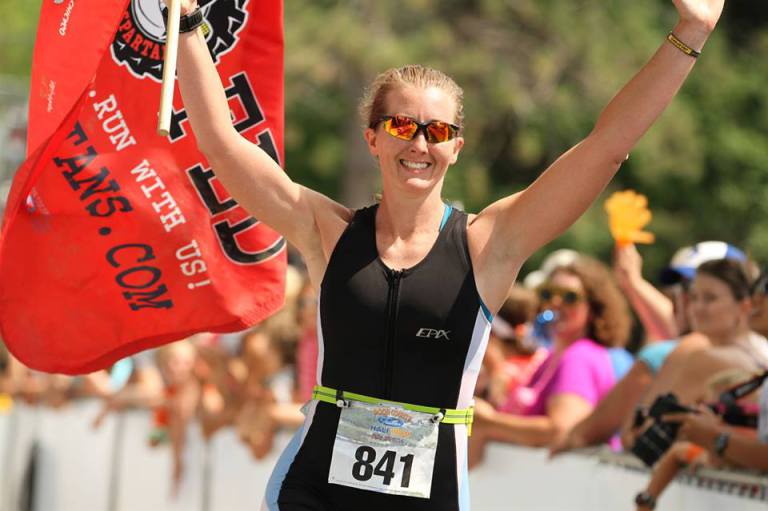
Then, it all came unchained.
When my dad died suddenly in July 2015, I gave myself some time to grieve, but felt I was better suited to being useful to the world instead of being curled in a fetal position under the covers of my bed. Work and exercise kept my mind off the loss…but unbeknownst to me at the time, I was bottling up feelings of guilt, of the loss of my biggest mentor in life, and of the subconscious stress of not knowing how to exist without his guidance. It took its toll on me, and over the course of the next several months I changed. I began to feel weak despite continued strength training. I was tired, despite getting more than adequate amounts of sleep. I was not my usual jovial self, despite every attempt to find happiness in the moment. What used to be a 15 mile effortless run suddenly became an exhausting desperation to make one single mile. I gained almost 30 pounds, despite battling the ever-sensitive teeter totter of calories in/calories out. My joints began to throb from lack of regular movement. I fully believe now that suppressing my emotional state from the loss of my father broke the dam that was holding back the diseases inside of me.
It took over 6 months of various testing to figure out the underlying problems…Long story short, I now battle three health issues that will affect me for the rest of my life: Hashimoto’s Disease (an autoimmune thyroid condition), an Atrial septal aneurism (hole in the heart wall), and a “functional upper respiratory obstruction” of unknown cause (NB: I would not wish a bronchoscopy on my worst enemy). I take medications and have an inhaler now, and will need these medications for the rest of my life. But the good news is that I feel better and more like “me” again. Granted, I’ll never be the athlete I once was, but the fact that I can run again and participate in events is enough for me now. I wanted to give endurance racing another shot but hadn’t planned on jumping back into the game until 2018, so I had plenty of time to rebuild.
But, everything happens for a reason. And playing it safe isn’t exactly my modus operandi.
In early 2017 there were rumblings among a couple good friends of mine about signing up for The Gauntlet, a 30+ hour endurance event in the small town of Molena, Georgia. Operated by 4 time Death Racer Matthew Waller, and assisted by a team of top notch people including Tanya Bickham and the venerable Andi Hardy of Spartan Race fame, the race promised to test mental fortitude, agility, and strength. From its registration page: “The Gauntlet will have athletes participating in running/rucking miles of wooded trails, carrying heavy, sometimes awkward objects, competing in time trials, and often times participating in group activities where teamwork is a necessity. Athletes who finish The Gauntlet will have been tested physically, mentally and spiritually.”
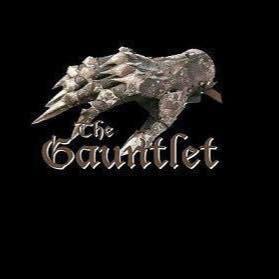
When you add in the fact that Matthew and Andi are friends of mine, it was a given that the race was a must-do. I signed up, excitedly looking forward to Labor Day weekend and my first trip to Georgia. My good friend and sister-in-arms Camie registered with me. My better half Rick agreed to crew me as well as be a photographer for the race. We were ready for a weekend of funishment.
In the days leading into the event, the Gauntlet Facebook page began to leak “hints” in various forms: video of Matthew juggling, a few references to Ancient Greece, a song of the Greek alphabet. I took mental notes as they were released, fully believing they would be useful later.
Many endurance events have a “Pre-Registration Dinner” the night before the actual event, and Gauntlet was no exception. Camie, Rick, and I showed up about 10 minutes before the stated start time of dinner – because early is on time, and on time is late. We’ve been around the block enough times to know that endurance race directors love to punish late arrivals. As we approached the doors to the restaurant, we were greeted by two Gauntlet volunteers, who instructed us to stand facing the wall, rucks on, in “at ease” position, silently. Camie and I did as instructed, and soon after a few other participants joined us. The first thing I noticed was that Camie and I were the only ones in workout clothing – we were expecting some form of exercise hazing from previous experiences.
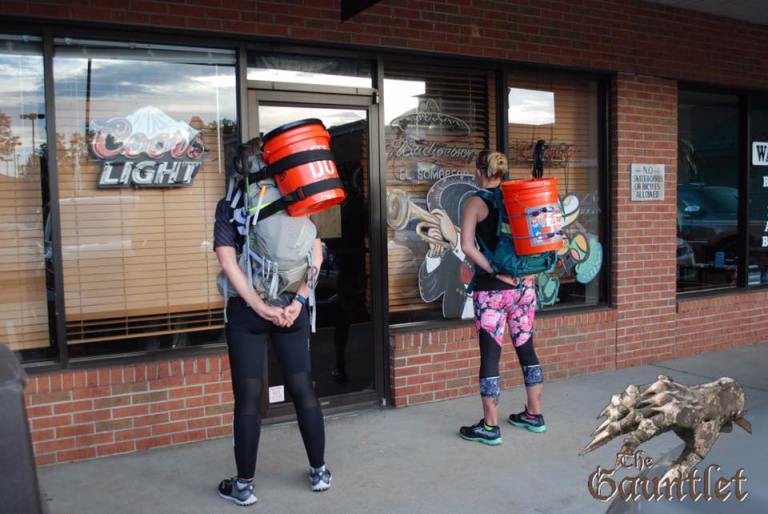
Once enough of us were lined up, we were instructed to bear crawl into the restaurant to our seats. I led the group into the building, to a reception of stares, laughs, and some cheers from the restaurant patrons. I chuckled to myself as we arrived at our seats and stood up to see the smiling faces of Matthew, Andi, Tanya, and the rest of the staff. They applauded our arrival and asked us to find our seats which were assigned by sandbags with our names on them, placed on the chairs. Each of us located our sandbags and sat – none of us dared to look inside at the contents though. Instead, we all learned a little bit about each other through small talk – for Beth, the Gauntlet was her biggest event yet. Allen, Brad, and Craig were all buddies who had been training together for some time. Royce was a local athlete who trained under Waller at his Crossfit gym.
The waiters came out to take our orders, and everyone made their selections except for me and Camie… We also have been through enough of these events to not risk actually eating dinner until we know it’s safe to do so – the last time I had a meal at one of these events, I was thrown into a “death by burpees” competition and almost ended up tasting my dinner twice.
I wasn’t making that mistake again. At the far end of the table I could hear Matthew and Andi commenting on how we refrained from getting food. “Go ahead and order! You’re safe!” Matthew said. “I’ll believe it when I see it!” was my answer, laughing at him.
While we waited on dinner, Andi called us to the back of the restaurant with our sandbags of goodies. We peeked inside at its contents – a 2 pound bag of whey protein, a bag of giant marshmallows (to remind us that we’re soft), some small fluffy balls (to give us “warm fuzzies” when we’re feeling down during the race) among other random paraphernalia. We were told that the bag and its contents were now part of our mandatory gear list and to be on us at all times once the race starts. Matthew then convinced me that it was really ok to order some food…so, a fajita burrito for me!
Shortly after, it was announced that another racer had arrived – Kert. He, of course, received some penalty burpees outside before bear crawling into the restaurant as we did. Then, more burpees were assigned to him before he was allowed to order food. The group of us continued chatting amongst ourselves until the restaurant closed up for the night. We shuffled outside with our gear and joked around with each other some more before going through a quick check of our gear items.
And then, Matthew broke out some juggling pins and asked us to practice. I flashed back to that video on the Event Facebook page and inwardly laughed, realizing now that the task was going to come up again at some point during the race. That being said, I can hold my own juggling balls, but I’ve never had the opportunity to juggle pins. We all gave it a try, and each of us failed…my hopes at that point was that pin juggling was not going to be a mandatory completion for the actual event.
Rick and I departed for our hotel, and I spent the rest of the night readying my ruck for the next evening. We got to bed early in an attempt to get as much sleep as possible before the race.
On race day I slept in until mid-morning, had a decent breakfast and finished packing up the food and water I needed for my ruck. My drop bin, chock full of extra food, a change of clothes, and backup gear in case something broke, was tossed into the back seat of our rental car along with Rick’s camera and backpack. I decided to stay off my feet as much as possible until it was time to head to the race venue (a short 15 minute drive away). Camie met us at our hotel mid-afternoon to finish up her preparations, and we followed each other out to Camp Thunder, the site of the event. Our goal was to arrive at 5pm sharp to avoid any wasted time, yet also be free of any late penalties.
We pulled up to the address marked by our GPS right on time, but there was no one in sight. Fortunately we ran into a race volunteer (who was equally as lost as we were) and he was able to call a race director for more specific directions. We were on the east side of the lake and needed to be on the west side…as Rick drove up to the entrance, a young volunteer greeted us. Asking us if we were racing or volunteering, I responded, “Racing.” His tone comically changed from calm to frantic – “You need to get all your stuff to the race site and have your car back down here in the parking lot in 15 minutes or less! Hurry!”
I snickered and waved thank you to him. You gotta love scare tactics.
Rick dropped me off at the top of the hill, I unloaded my things, and he drove back down to park the car while I readied my gear. Camie was driving Andi’s car, so she was able to park up close to the main race site, making things super easy. Tanya was heading up event waivers, and we were instructed not to come to her until we were ready to race. Camie and I double checked our gear and hung out together until about 5:40pm, when we felt it was a good time to get this party started. I took a brief survey of the other racers before leaving our camp site – there were a total of 17 of us who showed up. Almost 30 participants were registered…the ongoing joke in this genre of racing is that there’s always a sudden uptick of “broken toes or dead grandmas” that provide people the excuse of not showing up.
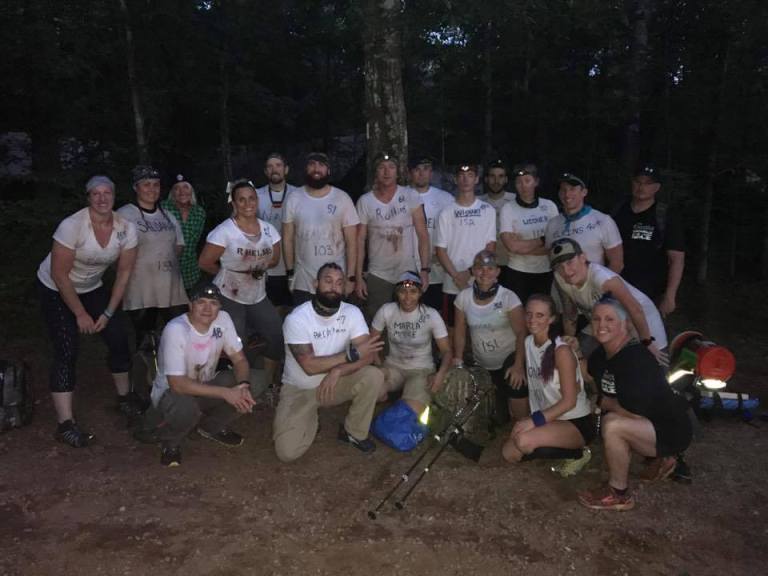
The Racers and Race Directors at the start of the event
We headed over to Tanya and signed our Death Waivers, and were then instructed to take the sandbags we were given last night at dinner and fill it up with 20 percent of our body weight – any weight under the target resulted in a 100 burpee penalty, but if you were heavy you were stuck with carrying the weight for the duration of the event.
This, of course, required a weigh in prior to filling our bags. Matthew was manning the scale. “I thought it was rude to ask a lady what her weight was,” I jokingly said. We both laughed as I stepped on the scale and weighed in at 166 pounds. So, I needed 33.2 pounds of weight. Camie and I set off to fill our bags, and we found a pile of rocks that would suit well. We both gauged our bags against each other so we could estimate weights – Camie’s felt about 5 to 7 pounds heavier than mine, and I was guessing mine was right at the 33 pound mark (I like to test myself and get as close as possible, there’s no fun in it for me otherwise).
I weighed my bag of rocks: 31.9 pounds. Off by 1.4 pounds…close! So, 100 burpees for me. The interesting thing was that Camie’s bag weighed LESS than mine – which was either the result of the scale not being zeroed correctly, or the bag not sitting properly on the scale. We both knocked out 100 burpees before adding some weight to our bags. I threw in 2 rocks and came back with a final weight of 37 pounds. Camie added two rocks….and suddenly weighed in at 47 pounds! We knew there was something screwy with that situation, but that’s how the game is played sometimes. Camie is a beast and she took that added weight with a smile on her face.
Our race numbers were written on our shirts (I was 113, Camie 114), and our rock weights were written as well. We were instructed to get our rucks with our bag of rocks and follow the trail to the river. I was carrying about 55 pounds at this point, and Camie was likely close to 70 pounds of pack weight. No matter though, we trekked down to the river singing 80’s songs and laughing.
We met Andi at the river, who instructed us to find a rock “about this size,” pointing to a rock that fellow racer Jessica was holding – she was the first to arrive to the area and was apparently exempt from this first task. Camie and I found our rocks and cleared them with Andi for size, then set them next to our rucks to begin a list of PT exercises that Andi had for us – all to be done in the river.
Push-ups. Tricep Dips. Burpees. Flutter Kicks. Mermaids. Scissor Kicks. Squats. Heel Raises. We knocked them all off one by one – holding our rocks when the exercise allowed, but keeping it dry per instructions (and still singing, by the way). Then we had to cross the river and back in as few steps as possible. Camie and I crossed together – we both had the bright idea to use “slips” as added distance to our steps. As I stepped out of the river counting 115 steps, Andi told me I had the lead thus far and could try again for fewer steps or continue on with the PT exercises. I had the feeling this “challenge” wasn’t going to reap me anything, so I stuck with my number and resumed PT. Camie’s step count was just a few behind mine and she opted to go out again (I think her 2nd number was in the 70’s after she mastered the slip walk technique).
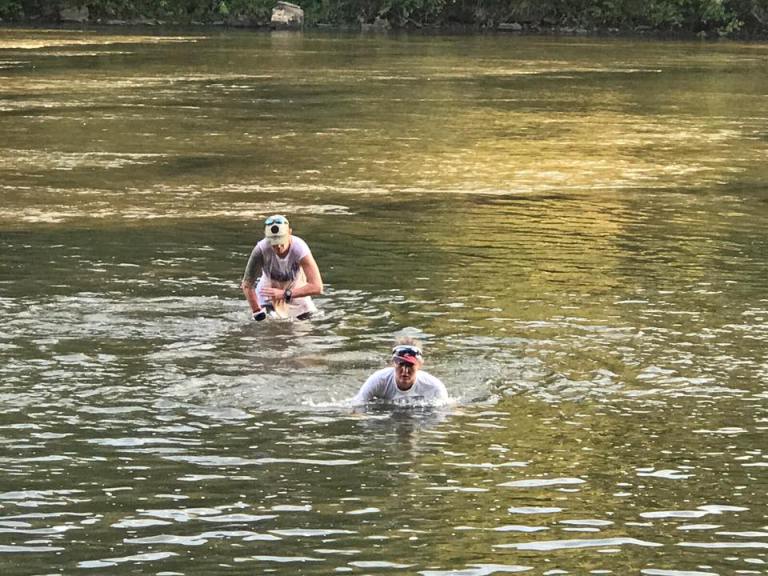
Camie and I slinking across the river
Andi called us out of the water during PT for instruction on the next task – we needed to paint our names on our rock using lowercase Greek letters, with a minimum of 5 letters to be used (so in other words, if you had less than 5 letters in your first name, you needed to use part of your last name). I had memorized the Greek alphabet prior to the race due to those online clues that had been dropped, but for the life of me I couldn’t remember how to form the Greek “D” in lowercase. Fortunately, there was a key to look at….Unfortunately, it was at the top of a steep hill.
So, Camie and I trotted uphill to find the key. We came upon a sign about halfway up the hill that was an obvious red herring (simple cursive versions of the modern alphabet). Up the hill higher, I could see the 2nd sign that would serve as our key, and we each found the letters we needed.
We set back down the hill and began painting our rocks, both choosing a crimson red paint that we purchased as part of our mandatory gear:
ανδε ωCamie and I both reported to the volunteer to double check our work. I was cleared, but because Camie didn’t use her full name “Camille,” she had to repeat her paint job. I was relegated to resume PT in the water while she finished up her task. It didn’t matter how much PT was completed, though, as it wasn’t for points…but I love being in the water, so I didn’t mind at all.
After about 2 hours or so of this, we were all called out of the water and asked to line up single file. We marched the short hike back to base camp, rucks and bag of rocks on our backs, and painted rock in our arms, and were told to place our painted rocks on the ledge of the pavilion. Then, off to the pond we went. The sun had set by this time and the sky was getting dark quickly.
Matthew explained this next task as a tribute to a man who many of us call friend – Patrick Mies. He was one of the victims of Hurricane Harvey in Texas, but in true Pat style, he took it in stride, posting a video on Facebook of himself wading through waist-deep water with his only dry belongings in his backpack; he spoke of how his ruck training had better prepared him for that moment (and he’s right – it’s just another reason why I love endurance racing). We racers were instructed to enter the pond water with our rucks on our shoulder exactly as Patrick did in the video, and make a lap around the edge of the pond at waist deep or better in the water. This was more difficult than it sounds, as the pond scum at the bottom was thick enough to suck off a shoe if you weren’t careful, and the weight of the rucks pushed you into the muddy bottom even deeper. Most of us couldn’t keep our rucks on one shoulder due to the weight/awkwardness of it, so our gear became water logged very quickly. A few racers’ gear fell out of their rucks; as my ruck got wet and the ties stretched, I lost my 100 feet of rope and the 2×4 block of wood that was secured to the outside of my pack. I had no idea I’d lost it but Camie found it floating in the water by the light of her headlamp and handed it back to me.
We hit the backside of the pond, and Matthew asked us to stop and gather so he could go over race rules. He called me out and asked me how many poisonous snakes were in the state of Georgia. I began naming snakes in response – Copperhead, Cottonmouth, Eastern Diamondback, Coral – as he opened up a poster board of snake photos, both venomous and nonvenomous.
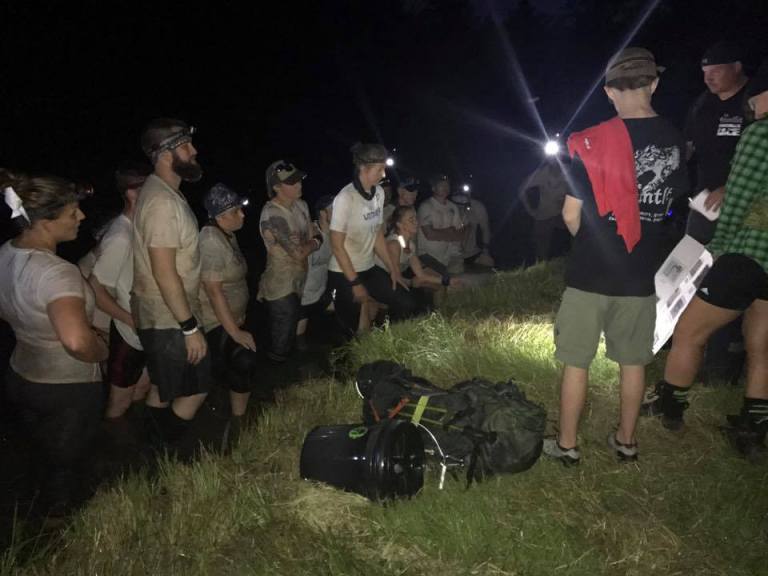
He reiterated the importance of snake identification in case of being bitten before going over the rest of the race rules. We all stood at the edge of the pond in the water as he spoke for about 15 minutes. During this time I made friends with a lovely egg-sized Wolf Spider who took refuge from the water on my leg. I let her hang out there for a bit before shooing her back into the grass as the rules talk ended. Matthew instructed us to get out of the pond and grab our gear (which he graciously allowed us to toss on the shore of the pond during the talk), and report back to the road leading to camp.
Now, our rucks were extremely heavy by this point due to the added water soaking. It took a good heave to get mine on my back and felt close to 75 pounds by this point. The night was damp as well, so I knew it wasn’t going to air dry very quickly, either. Regardless, I felt good – my lungs felt clear, my legs were strong despite a recent ankle sprain, and my energy levels were up to par. My goal was, simply, to finish this event, and in my mind, I knew I could.
We all reported to the road as instructed where we were told that we could drop our rucks at camp and report back down to that location – a time trial was next up on the task list. Now, while the race directors kept reiterating that “It pays to be first,” there’s a certain strategy that often comes with these events: Do you go all out for the best placing possible and risk destroying your legs for what is yet to come? Do you take it easy and conserve energy?
I decided to shoot for a middle of the pack finish, because to be honest I’m not a fast runner by comparison, and I knew my lungs would not hold up to a sustained all-out effort. The race distance was unknown but it was two laps of a paved trail. I decided to take the first lap at a controlled pace and then push on lap 2, once I knew the distance to cover.
The gun went off and 10 runners shot out to the front. I settled into a pace that I felt was sustainable for short distance running, and focused on controlled breaths as I watched the path in front of me, lit only by my headlamp. Lap 1 ended with an uphill climb as I passed another racer and started off for lap 2, under a quicker pace. I passed a 2nd racer about halfway through the second lap, seating myself in 8th position coming into the finish. My watch ticked off a 7:40 mile average about 90 percent in to the race, so the course was just over a mile long.
Middle of the pack. Right where I wanted to be. Camie was 4th overall and 1st female (and I expected nothing less). My lungs felt a bit tight from the heavy, humid air, but it was nothing a little puff from my inhaler couldn’t fix.
After the time trial, we were split into two groups for some community service for the camp: My team was to smooth out an area of ground, clearing out brush and filling in holes. The other team would be moving gravel. This was a relatively short task, taking about an hour to complete. My team worked quickly to clear our designated area – I joked around with my race mates and asked them to tell a little about themselves. When we claimed to be finished, the volunteer overseeing us asked us to army crawl and then barrel roll through the area to ensure it was free of rocks and other sharp objects.
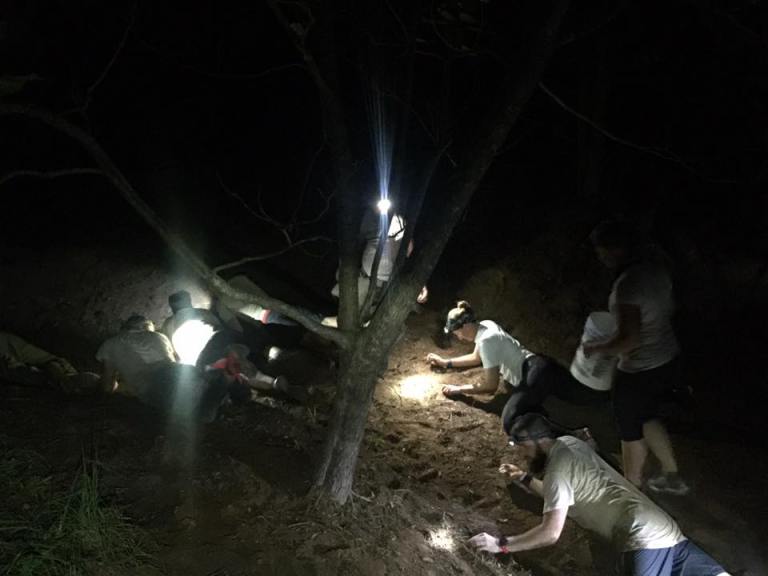
Next task: gather our rucks, line up in order of our finish and prepare for a long hike. We followed a path along the river…In the darkness it was difficult to spot any landmarks as we passed by – it’s a habit of mine to constantly orient myself to the trail, but when the light of your headlamp is all you have to see with, orienting yourself becomes exponentially more difficult unless you’re able to stop and really assess your surroundings. About 2 miles into the hike we were asked to stop and face the forest beside us. Matthew explained that our next task was to hike to the waterfall following the trail. He asked us to start pairing off by time trial finisher number: 1 pairs with 17, 2 with 16, 3 with 15, and so on.
I quickly realized that I was to pair off with 10, leaving the 9th finisher without a partner. I turned to Matthew and asked if Number 9 was to be added to my team.
Matthew smirked and responded, “You’re the lucky threesome.”
I laughed, but then realized what we were in for – our ankles were to be zip tied together in order to make this next trek. Number 9, Brad, was to be the unlucky middle person between me and Number 10, Scott. This task was for points that would be applied to your final finishing position. And, to add to the difficulty – breaking the zip tie would result in a DNF.
At the sound of GO, we all began moving…but my team was forced to a snail’s pace. The trails, barely wide enough for two people to pass, were impossible for a team of 3 to walk side by side on. We were forced to side shuffle for most of the trail. The other team’s headlamps faded far into the distance…we were completely alone. In a way, it was comical – three adults, linked at the ankle, with weighted rucks on our backs, trying to snake our way down a narrow path without falling over. The ties began to cut into Brad’s ankles, and he began to stress that his bad hip was starting to ache on top of that pain.
It took us over an hour to go one mile. The three of us grew frustrated with time, but talking each other through the trail calmed our nerves a bit. We continued to trudge on when I saw a headlamp coming back towards us – it was Matthew, equipped with scissors to cut our ankle ties. Apparently he realized just how long it was taking us and came to set us free. I asked him if we were going to get any sort of consideration for being the unfortunate team of three – Matthew responded, “The consideration was that I came back to cut you loose.”
Fair enough, I said to myself.
It was another ¼ mile to the waterfall yet…by the time we arrived, some of the racers (Camie included) were already finishing up what they had set out to complete: fill your water bucket with water from the falls, using only your shoes to collect the water.

The buckets were to be weighed before departure: minimum requirements were 24.9 pounds for the ladies, 32.9 pounds for the men. Knowing that a gallon of water weighs 8 pounds and assuming that 0.9 pounds was for the bucket, I knew approximately how high I had to get the water level. I began shuffling as fast as I could down and up a wet, slick stairwell to collect water in my shoes; keep in mind that trail shoes are designed to drain water easily, so this was no easy task. After about the 10th trip to and from the falls, I learned that if I stacked the shoes and kept the heels pointed downwards, I could keep more water with me. Still, it took about 100 trips up and down to collect the right amount of water. I didn’t have time to face a penalty if he bucket weighed too light, so I made sure I put in a little more than what I needed.
Final weight: 29 pounds. Instructions were to take the water back to base camp.
Last person in, 4th to last to leave. So, I’d made up a little time.
But there’s something about being awake when you normally should be sleeping that just messes with you…and this is exactly why most endurance races begin in the late afternoon or early evening. It forces you to endure two periods of darkness. The enveloping blackness of night can make even the strongest competitor crumble if their head isn’t on straight. It allows things to consume you that otherwise wouldn’t be bothersome… it shifts your focus easily if you’re not attentive to your goal.
And it got to me this time. Instead of focusing on grinding towards the finish, I became fixated on the points system of the race.
As I hiked the return path, I began crunching numbers in my head – as racers dropped out of the race, the number of points awarded for first position would drop. Unless I finished first in just about every task there forward, there was no way I would feasibly make up the deficit I’d just incurred. As I walked alone back along the trail, I kept running the numbers in my head, growing angrier by the minute. The night was stiflingly silent except for my footsteps and the occasional slosh of the water in my bucket as I switched grips between my hands. The silence of the night only drove me deeper down the rabbit hole in my mind. My anger fueled my speed as I trekked back down the trail to the main road, now carrying a roughly 75 pounds on my back and 29 pounds in my hands. I peeked at the pace on my watch: just under a 14 minute mile, not bad for carrying over 100 pounds of extra weight.
I hit the main road that we hiked in on, and froze – I couldn’t remember which direction we came from. To the left was what looked to be a water crossing. To the right was dry road. Neither direction looked memorable to me in the darkness of the night.
Shit. I didn’t know which way took me back to camp. I had to take a gamble, and I chose to go right.
About ¼ mile down the path, I came to a gated dead end. I chose poorly – whatever time I’d made up hiking fast on the trail was more than lost now.
I about-faced and high tailed it back in the other direction. I soon caught up to Scott, the gentleman I was co-zip-tied to and who left after me at the waterfall. I said hello as I breezed by him, keeping with my strategy of switching hand grips as I moved. After a few minutes of passing Scott, I could feel myself starting to slow and my hands beginning to ache. Scott caught up to me and passed by again as we grew closer to camp. I saw the lights of the pavilion and Tanya sitting at the table as I finished my hike up the trail. Rick was there, too…he saw the look on my face and knew I was angry.
“Get yourself something to eat and drink, and let me know when you’re ready for your next task,” Tanya said.
“I don’t need food and water,” I responded flatly. I was doing my best not to be rude but I know my emotions were showing. “Just tell me what the next task is.”
“Follow the road up the mountain to Andi,” Tanya responded. “You’ll get further instructions there.”
I returned to my drop bin momentarily to pick up a couple more candy bars for the hike up. Rick followed me to my bin to try to calm me down, but I wasn’t having any of it. I’m embarrassed to admit it now, but in that moment all I could think of was how I had been cheated. Never mind the fact that a good lot of the racers were carrying more weight than I was. Never mind that Camie had an unfortunate weigh in with her rocks that forced her to carry more than 18 pounds than what was required of her. The dark of night consumed me and all I could think about was how I had been “treated unfairly.”
Me, not we…not Brad or Scott who were tied with me. ME. I had forgotten that, often times, these events are a reminder of how life is not fair. You can either make the best of the cards you’re dealt, or you can do nothing but whine and cry about your sorry situation. Normally, I take the path of the former. This time, I chose to whine and bitch. I lost sight of my goal.
I asked Rick how far Camie was in front of me. “At least an hour,” was his response.
That lit a new fire under my ass. I went from angry to fire-spitting livid. I grabbed my bucket and headed uphill, leaving Scott in base camp while he switched out gear.
About a quarter mile uphill I met up with another racer, Josh, as he sat on his bucket. “Do you know which direction to go?” he asked as I surveyed the lands. Tanya said to follow the road…which was gravel up to this point. In front of us was a grass and dirt path. To the right the gravel continued. Neither of us could see beyond the span of our headlamps, so we couldn’t determine how far each path was.
“Well, Tanya said follow the road. That, to me, means gravel and not grass,” I said to Josh. I headed off to the right to see where the gravel took me, but about 150 yards down, it dead ended at a pavilion. Wrong again, Andé…I yelled back to Josh that the dirt path was the correct way to go, and we both headed up the hill. As we rounded the corner, we were met by Jessica and David, coming back downhill with empty buckets. “At least we know we’re losing the water at the top,” Josh said as we continued our hike up.
As grass and dirt transitioned to the famous red dirt road of country song fame, I began to get a bit of a lead on Josh. The hill was steep and there were a few moments where I had to put the bucket down to catch my breath, but focusing on the top of the tree line kept my motivation up as it grew ever nearer with each footstep. The night sky was clean and crisp, allowing the stars to shine brightly in the atmosphere – they provided me a mild sense of calm amid the storm that was raging inside of me.
Must. Make. Up. Time. I kept repeating that in my head.
Rounding a corner and reaching the peak of the mountain, I found Andi and several other racers who were all focused on the next task. Andi greeted me with a smile – she’s always smiling – and asked how I was feeling.
“I’m not gonna lie, Andi. I’m having a very difficult time controlling my anger.”
“Look,” she said, “I heard what happened. There’s still plenty of time to make up points. You’re still in the race.” I thanked her for her kindness, but math never lies. There was no feasible way of catching up in the points game. I kept trying to surrender myself to that thought and let it go, but I just couldn’t. The darkness wouldn’t let me. My body was officially being fueled by caffeine and hatred.
I looked around at the other racers, who were intent on creating fire. “What’s the next step here, Andi?” I asked.
“You must create a fire without the use of matches. The flames have to reach 18 inches in height to pass this task,” Andi responded.
I set to work, gathering stones to make a fire ring and then setting out in search of dry brush. It was around 3am by this time, so everything was covered in dew and was wet – none of the small scrub brush was dry enough to effectively be used as tinder. Instead I grabbed some small sticks and a few leaves that were protected from dew to start the flames, and I found a dry branch that I could break up to create the actual fire.
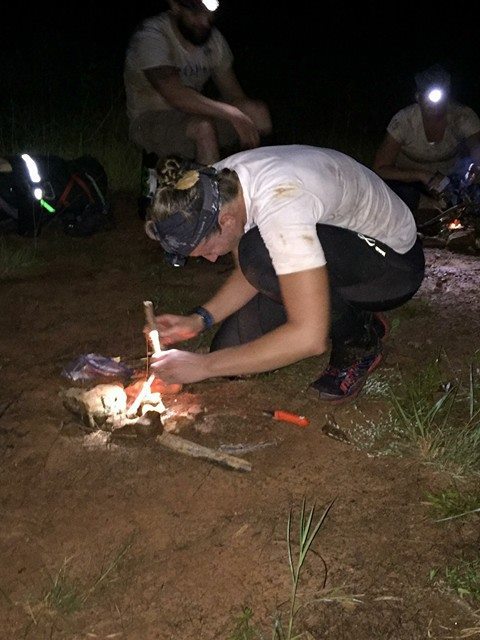
I grabbed a half cube of some WetFire from my pack and tossed that into the fire ring, threw a few pieces of tinder on top, and set it on fire with my spark igniter. It caught ablaze instantly, and I used the larger sticks to form a tepee over the fire in an attempt to get the blaze to the required 18 inches in height. Unfortunately the larger sticks were still too damp and wouldn’t catch. The fire went out.
Determined to complete this task quickly, I trekked deeper into the woods and found a dead tree with plenty of dry wood. Snapping off several branches of various sizes, I ran back to my fire ring and started over. This time, the blaze caught on to the larger sticks – I added new ones to the top to encourage the flames to rise higher, and then tossed another half cube of wetfire on top to give the added “oomph” it needed to meet specs. Wesley, one of the volunteers, measured my flames and called it good. It took me about 25 minutes to complete this task; Andi then told me to douse my fire with my water bucket, then remove my socks and shoes to stamp out the ring (purely a scare tactic, the water killed all the heat in the pit).
As I was putting my socks and shoes back on, I saw Camie come trotting up to the area. “Where have you been?!” she yelled, “I’ve been wondering what happened to you!”
“I don’t wanna talk about it,” was my response. “What are you doing? Running laps?”
“Yep, you can get extra points for completing laps after finishing your fire task,” she said.
A brief glimmer of hope rose in me with that piece of information. I found Andi and asked her about the laps. “You need to report to Tanya first, back at base camp. She’ll give you info for the next task.”
Now, it doesn’t take a genius to know that I was coming right back up that mountain after going down – all the lead racers were where I stood, completing these laps, while the rest were either still working on fire starting or had yet to arrive. I knew I was being sent down just to hike right back up.
OK, I thought to myself, maybe if I can get down and back up fast enough, I can get a lap or two in. Getting at least one lap done would make me feel better about my position.
I trekked down to base camp and met up with Tanya, who repeated to me about getting food and water. “Next task, please,” was my response.
“Head back up the hill to Andi, she’ll tell you what to do next.”
Back up I went, this time 29 pounds lighter without the water. The hike was much simpler now that I knew where I was going, and I rounded the corner to the peak, ready to get some running in.
No joke, the VERY SECOND that I reached “Camp Andi,” the time hack was called. No extra laps for me…I looked up at the sky and took a deep breath to calm myself and then looked around – 3 racers did not complete the fire task and were cut from the race (although there was a “buy-in” option back at base camp).
We were down to 13 racers…at least I was among those thirteen, I said to myself.
The group of us hiked back down the mountain to base camp again, and I walked with Andi for part of it, who asked me if I was feeling any better about my race. “To be honest, I’m not. I just need B.O.B. to come up, that’s all I really want to see right now,” I responded.
Most of us who’ve “been around” know that B.O.B. (the Big Orange Ball that is the sun) is what will make things right in our minds once again. I knew at this point that I’d made a critical error in my own judgement and let the night drive my thoughts. I was looking forward to daybreak.
We reached camp and were given a few minutes to refill our hydro packs and get some food. Camie and I chatted softly to each other while we replenished our packs, and then lined back up for the next task, following Andi down the road and across the field to three trailers of canoes.
Dawn was breaking, and I was already starting to feel better.
We were instructed to retrieve a total of 13 canoes from the trailers and transport them to the river, which was about 500 yards away. Our rucks needed to be placed in the canoes…meaning that, if four racers were carrying a canoe, then there would be anywhere from 300 to 400 pounds of weight inside, plus the weight of the canoe, of course. Camie and I teamed up with two other women, Marla and Amy, and positioned our rucks evenly along the boat. All of the canoes needed to be carried together, so if one team needed to rest, we all needed to pause.
The signal was given to begin hauling canoes, so we four girls heaved the boat up and began waddling towards the river. It wasn’t but a few steps in when a rivet broke on one of the handles – the boat had too much weight in it. Andi made the snap decision to allow one of us to carry our ruck on our backs, so Camie removed hers as we knew she had the heaviest load. Still, having 4 women to the canoe proved to be a disadvantage. So, Marla and Amy switched boats with Josh and Alan, and our new team made easy work of moving a few canoes down to their rightful locations.
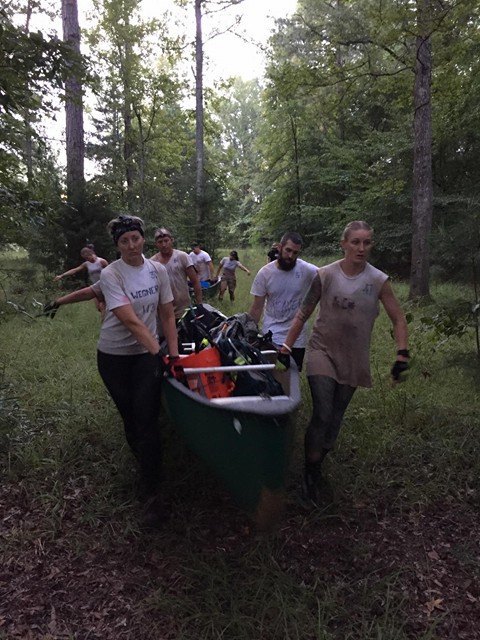
The next hour or so consisted of PT with the boats – triceps dips, incline and decline push-ups, and so on, followed by using our buckets to fill one canoe with water and then practice shoveling it out with our paddles. We then hiked back to the open field for a game of “Musical Rocks” – akin to musical chairs, but with the painted rocks we were asked to bring with us prior to our last departure from base camp. Andi played a song on her phone – which unfortunately was hard to hear unless you were in front of the speaker. If you were left without a rock when the music stopped, you were relegated to the center of the circle to do burpees. I was among the first to the center as I wasn’t within good ear shot of the music, but I assumed this was just a silly filler task that didn’t really hold a lot of weight. Fortunately, I was right about that.
We returned back to base camp and were given about 20 minutes to prepare for our next task – all we were told was to prep for covering several miles on foot. Rucks were not required, but we were asked to bring whatever we thought would be necessary for the task. With such vague instructions, it was impossible to gauge whether we were going to need any of our necessary gear for any of the task’s duration. I took the gamble and pulled my running hydration vest out of my drop bin, shoved a couple of gels in there, and hoped for the best. Camie went with the opposite perspective and opted to take her ruck, minus any extra weight. We decided to hang together for this task in an effort to keep our paces up.
We were given directions to a house a few miles away, where at that location we were to meet Rick to retrieve our next item. The time hack was 2 hours and 10 minutes, anyone not arriving before that hack time would be cut from the race. So, Camie and I started off down the road at a solid pace, with the plan to follow “ultra running rules” – meaning that we would walk any uphills, and run the flats and downhills. Up ahead of us was the youngest racer, Gavin. Freshly 16 years old, he could run like the wind and handily gained a sizeable lead on Camie and me. We two ladies split the rest of the field, losing sight of our next competitors after about 2 miles of running. During this time, Gavin picked up a friend – a little Beagle dog began to trot alongside him, which made us smile at the sight of it.
After noticing that Gavin was no longer making any more gains on Camie and me, I called out ahead to him and asked if he wanted to hang out with us. He obliged and the three of us continued to trot along the gravel road until it transitioned again to a red dirt road that slowly wound uphill for a good mile or more. The sun was just starting to peek out from behind the treeline, and I knew the temperatures were going to rise quickly. After just about an hour and a little over 5 miles of distance, we found Rick who handed each of us a raw egg and asked us to carry it back to base camp without damaging it.
Camie brilliantly remembered that wrapping our head buffs around our wrists and tucking the egg safely within the buff would protect it and save our hands from having to grip the egg for the trek back. I looked at my watch and muttered to the other two that if we only had a little more than an hour to get back to camp then we were going to have a tight timeline, and everyone behind us was going to be cut…which I felt was unusual given we weren’t even 24 hours into the race yet. Not soon after I said that, Rick drove up behind us and said that an hour had been added to the time hack due to a miscalculation in the overall distance.
Phew…we could take our time getting back to camp.
We continued to follow our ultra run plan, which worked wonderfully for all of us. With less than a mile to go and with no other racer in sight, we decided to walk the rest of the way in. I turned to Camie and Gavin and asked them if they would be ok with me leading them into camp so I could try to make up some of the points that I’d lost out on earlier in the race. They both agreed to the plan, and the three of us arrived in a single file to meet Tanya at camp, who took our times and told us to meet Andi back at the field.
Andi’s next task for us was…interesting. We needed to crack the egg and pour the contents into our mouths, then do 100 burpees while trying not to break the yolk. After the burpees were completed we needed to spit the egg out to prove the yolk was intact.
Needless to say, it sounded gross, and my gag reflex was going off just at the thought of it. Gavin hated eggs as he told us during part of our hike back, so I felt really badly for him, too.
Fortunately, Andi offered us a challenge to reduce the number of burpees – we could juggle. Success in juggling pins would knock off 50 burpees, and successful softball juggling would knock off 20. I knew that I couldn’t do the pins, but since there was no penalty in trying, I gave the softballs a go and was able to make the required 3 full cycles with the them. So, eighty burpees for me instead of 100.
I poured the egg into my mouth and did my best to keep my head down to avoid letting the contents irritate the back of my throat. My burpees were slow and calculated, with as little jumping as possible to avoid breaking the yolk.
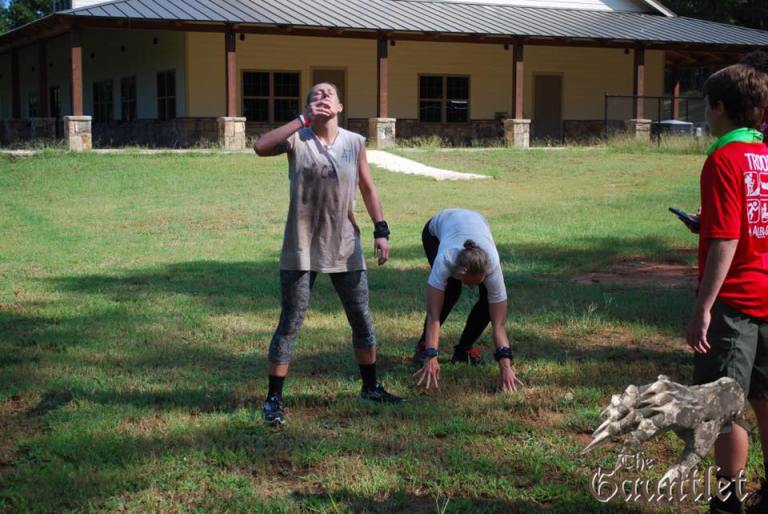
Camie pouring in the egg, while I start off on my burpees
I spit the egg out after I completed the last burpee, and the yolk held up! I was so relieved…but it was still gross!
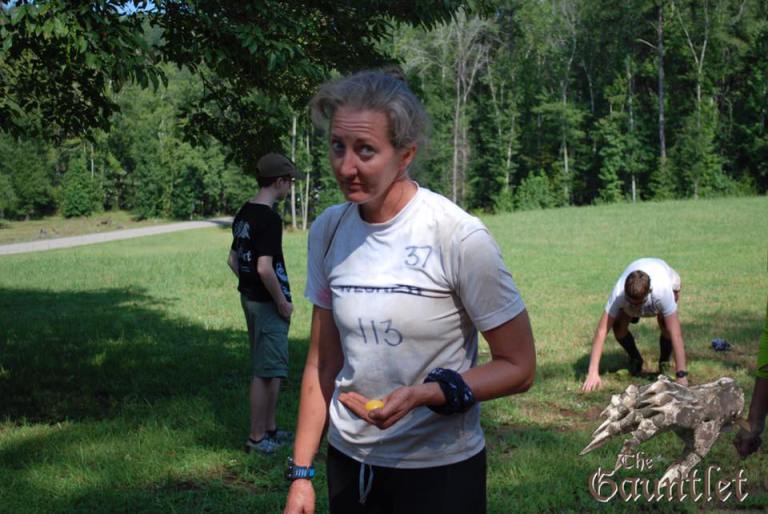
The volunteers cheered at the sight of it, but I had my eyes locked on Matthew…”Hey, Waller! I’ve got something for you!”
Matthew smiled and looked as if he didn’t know what to do as I walked up to him and smashed the yolk on the front of his shirt. “I love you man, but you deserved that!” I laughed to him. We hugged and he congratulated me on the last running task finish placement.
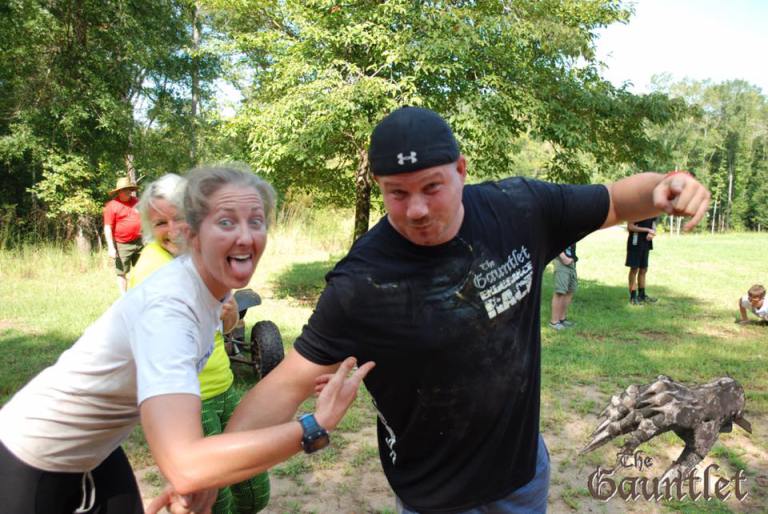
The yolk’s on you, Waller!
I was able to rest my legs for a few minutes while Gavin and Camie finished up with their burpees, and then we were asked to grab our white bed sheets (another required gear item) and make a toga, then report down field for the next event: the Gauntlet Olympics.
This task would be the last one for points, we would learn later. It consisted of the RD’s take on several classic Olympic events: Javelin throw, Shot Put, Discus, Hurdles (with burpees in between, of course), a barefoot sprint, over the shoulder atlas stone tosses, and the broad jump.
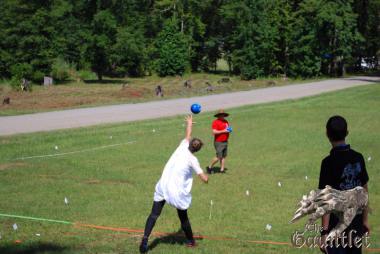
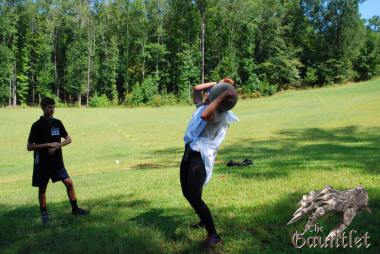
The shot put and the Atlas stone over-the-shoulder throw
I’m good with picking up heavy crap and moving it, but anything involving speed or jumping is a proverbial Achilles Heel to me. After this event had finished up, I was in a distant 3rd place for the women, but by this point I had regained control of my mind…I reminded myself that my original goal was to just try to complete the event, regardless of how it had to happen. Hell, I was lucky to be racing at all given all the health issues afflicting me. I needed to be thankful for simply being here, in this moment, racing among friends.
Once the Olympics finished up, we reported back to base camp to load up our rucks – we were given about 10 minutes to reform in line. I grabbed my stuff, and Camie and I lined up with a couple other racers – Gavin and Craig. Camie decided at the last second to grab something else for her pack, but the race directors then called another hack and forced any racer not already in line to stand behind us. We few racers in line were given a short head start while the rest had to do a burpee penalty for being late to the line-up. We were instructed to run to our canoes where we left them by the river and follow the water downstream until we saw a set of balloons – green on the left shoreline, red on the right. Our next task was to involve land navigation.
Craig, Gavin, and I trotted off to the canoes, throwing our rucks into the hull and dragging them down the bank – I helped push Craig in a little bit, and Gavin helped me into the water. Craig and my canoes began drifting to the right, but it was otherwise very difficult to see which direction the water was heading. We followed the push of our boats to the right as some other racers began to arrive. About ¼ mile downstream though, we realized that there was an eddy at our launch location, pushing us in the opposite direction of the actual current!
I swear, I’ve never had more directional problems than I’ve had during this race. The vast majority of the other racers had followed us upstream, and we yelled to them to turn around. Yet again, I went from a good position to back of the pack. I’m fairly experienced with navigating light watercraft through moving water, however, so I had an advantage of being able to read the water ahead of me, avoiding shallow areas and back currents. I was able to gain some positioning as I passed some racers whose canoes became wedged between rocks.
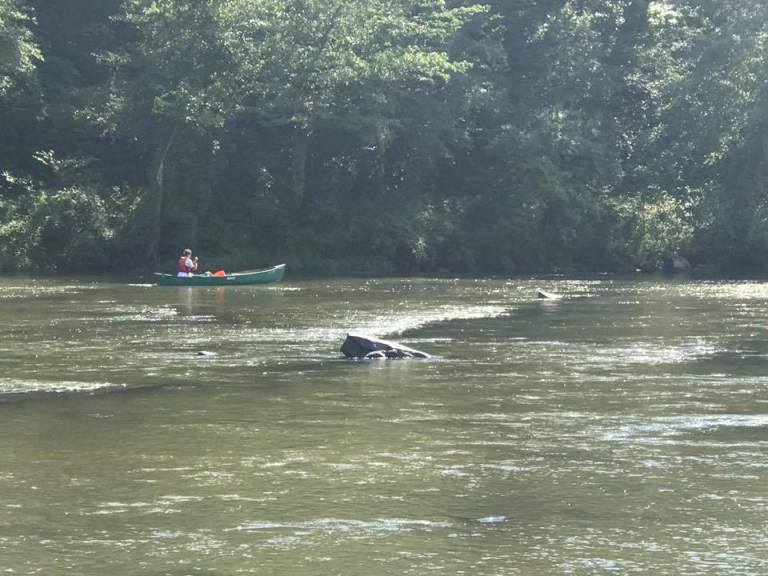
I sighted the green balloons and parked my canoe on the shoreline, using my ruck as the anchor. We were all given cards with degrees and pace counts prior to departing base camp, and needed to find 5 points from a common starting point on the “green balloon” and the “red balloon” sides. I made short work of the first 3 points on the green side, finding a ziplock baggie at each point with a letter inside. I took one letter from each point and returned to my canoe to cross to the other bank to find the final two points.
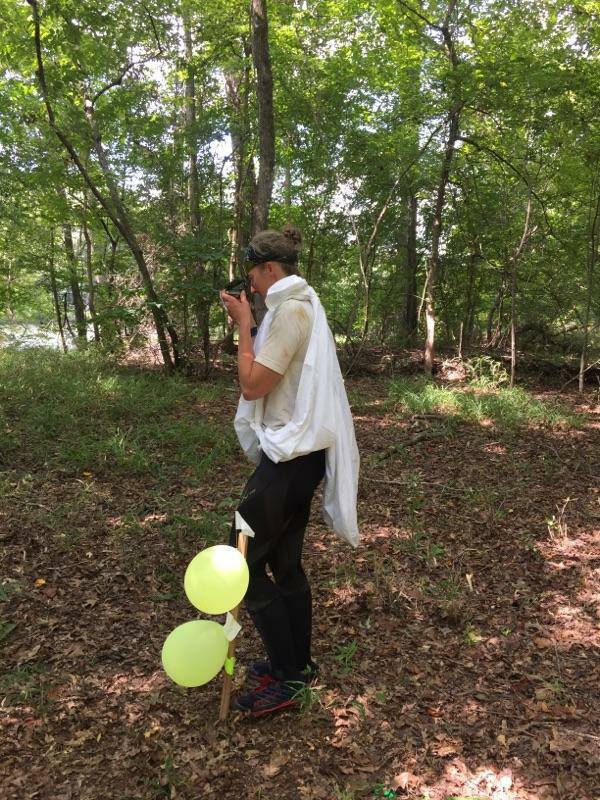
Sighting out the first point. Still wearing the Toga, mind you…
The rapids at this crossing were too strong for me to navigate, however, and I was swept downstream which forced me to park my canoe about 200 yards from where I wanted to be. I hiked back to the start points and found the remaining two caches…but my final location’s ziplock bag was empty, void of any letters scribed on a notecard.
I decided to walk my canoe back across the river instead of paddling, to avoid fighting the current. I reported to Andi and told her that I was missing a letter at the final cache site. I took the remaining 4 letters and quickly figured out I was missing an “A” to spell “Hades”, the god of the underworld. She congratulated me on completing the task and said I could head back upstream to our launch point.
I glanced back upstream at all the rapids…this was going to be interesting. But I was the first racer done with this task, so I had plenty of time.
After a futile attempt at trying to paddle the canoe against the current, I leapt out of the boat and began walking it back. Jessica, another racer, caught up to me and we both trudged upstream slowly. Usually, the water speeds are a bit slower along the shoreline, but this river had no rhyme or reason to it. The rocks were slippery and sharp, leading to many a fall. At one point the rapids were so strong that I couldn’t move against them at all for several minutes. I just hung on, hoping not to get swept under the water…and then I fought for every inch of gain. It took me 10 minutes and several audibly loud F-bombs to go 20 feet. Finally, after a long and slow 1.5ish mile hike through the river, dragging the canoe, I arrived at calm enough waters to be able to get back in the boat and paddle the remainder of the distance. Jessica got a good lead on me at this point, she being much lighter and stronger than I am. Craig caught me as we came into shore, and Andi was there to greet us and help pull our canoes back out of the water.
I sensed that the race directors were not expecting us to take so long coming back, but the current was simply unavoidable. I sat on my bed sheet toga and removed my socks and shoes to dry my feet for a while, as we awaited the other racers’ arrivals. I took inventory of my feet: no blisters, only mild trench foot from being wet for so long, which corrected itself during that waiting time. My left ankle was a little swollen from the old sprain injury I suffered from earlier this summer, but it didn’t hurt. Overall, I felt good. After about an hour, we got a report that the final racer’s (Marla) boat sustained some damage and was taking on water – she was being rescued and would be returned to camp without penalty. Thank goodness she was safe!
The rest of us carried the canoes back to their original location and returned to base camp for our next big task – another long hike. We weren’t given a total distance but Andi said it was longer than our first hike. We got the happy news that we could leave our bag of rocks behind this time, phew!
After receiving directions on how to get to our next checkpoint and told we had to make it there in under 3 hours, we racers all headed back out onto the road and began our long trek. Camie asked me if we should stay together but I urged her on ahead. She could handily outrun me fully weighted down, and I didn’t want to slow her at all. Her ruck faded into the distance as I set out at my own pace. I slowly passed every other racer and soon enough, found myself alone…except for the Beagle dog who found me again at the base of the long red dirt road. It was dusk and the sun cast an orange glow behind the tree line as the moon rose from the east….such a beautiful sunset. I named the dog “Buddy,” and spoke to him as we hiked the road uphill together. “You’re a good little dog,” I repeated to him over and over, and he’d look up at me with a tongue wag as if to say, “I know, thanks.” I began to make up songs that I sung out loud, to pass the time:
“I’ll hike right up this red dirt hill, the top will be here soon,
And if I have a bit of luck, I’ll get to see the moon.”
Stupid? Maybe…but it kept my mind in the game. You do weird things when you’re tired and in solitude.
At the peak of the red dirt road, little Buddy jumped back into the forest and disappeared. I continued my trek downhill and hooked a left at the T intersection, as instructed. By now it was dark and I was being led by the light of my headlamp. My walking sticks created a metronome as I hummed to myself. A little after 9pm, I arrived at the destination, finding Camie as expected, and Craig, who knew the area well and intelligently found some shortcuts to cut off some mileage.
Andi and Matthew were there, welcoming us to “The Soul Crusher.”
The Soul Crusher was an obstacle short course – our instructions were that we needed to complete all parts without failure in under 11 minutes. If we failed, a minute was added to the total time allowance, and we were allowed as many tries as we needed to complete it as long as we met the time cutoff of 11 pm. The course consisted of:
- 10 overhead presses with a slosh pipe: men’s probably weighed 50 pounds, the women’s felt about 35 pounds.
- Weighted sled drag: men’s was approximately 100 pounds, women’s was 70 pounds
- Balance beam: two wobbly sets of 2×4 wood planks, narrow end up – traverse without falling off, run approximately 25 yards and then return across the beams, again without falling. A fall would require restarting from the beginning of this section
- Atlas stone carry (classic Spartan Race stones) – Men around 95 pounds, women around 65 pounds. Carry it about 30 yards, do 5 burpees, and return the stone to its starting position
- Farmer carry with two 5 gallon water jugs (each jug felt about 30 pounds each): same for men and women – carry about 30 yards and return to start
- Concrete cylinder carry: Probably 60 pounds for men, 30 pounds for women.
- Stump jump – approximately 10 vertical log posts that needed to be traversed without falling off, run about 15 yards and then return across the logs. This was another restart obstacle if you failed. Women had to carry a 10 pound kettlebell across this obstacle, and the men had (I think) a 25 pound kettlebell
- Overhead tire carry: Straight arm overhead carry of a car tire about 75 yards, then return to start
- Rope climb (approximately 15 to 17 feet of vertical to ring the bell)
The course, on paper, doesn’t look too terrible…but add in the facts of being awake for about 30 hours by this point, it being late in the evening so the grass and anything wooden is slick with dew, and that running by headlamp can mess with your equilibrium a bit, and you’ve got a force to reckon with.
Camie was the lucky first volunteer, and I cheered her on as she took off on the course. She made it look easy, not failing a single thing, and finishing in a little over 9 minutes. She was able to now rest until 11 pm when racers were allowed to leave back to base camp.
I decided to go next…and I was afraid. I thought of my recent left ankle injury and how it still wasn’t quite normal, which made balancing on narrow objects a harrowing task. But I’d come too far to quit now…I picked up the slosh pipe and started with my overhead presses, handling them without issue, as well as the sled drag.
I hit the balance beam and made it across the first pass but fell off on the second…back to the start I went. I trotted back up to the beam and got to the very end of the first set when my right foot slipped off the side of the plank. I landed on the ground on the outside of my right ankle…the “good” ankle, mind you. I felt a sharp pain as I landed and fell to the ground.
In overthinking about babying my left ankle, I ended up spraining the right one. I’m such a dumbass.
I limped back to the start area…my run was over. Tanya (who happens to be an awesome RN) came to assess me and offered an ace bandage or a soft ankle brace. I chose the brace, as I was already wearing compression socks and didn’t think an ace bandage would fit inside my shoes well. Emotions again took a stronghold over me, and I teared up as I thought that I’d made it this far just to get a medical DNF. I grabbed an ice pack from Tanya and sat on a log, feeling sorry for myself. I watched other racers make that damned course look easy and beat myself up for not being better.
Rick was serving as the counter for the slosh pipe, and tried to console me in between racers. I watched my ankle begin to swell and began to battle in my head: the racer in me wanted to keep going. The doctor in me knew it was a stupid thing to try again. I told Rick of my internal struggle, and he responded that I needed to make the decision I thought was best.
I began to cry quietly. Logic took over and I knew I should quit now so not to risk possibly worsening the injury. Then, Wesley (the same volunteer who measured my fire the last evening) came over and sat alongside me.
“Look,” he said, “I know you’re not a quitter. I’ve been watching you and I can see that. You’ve got to find a way to make this happen! You can’t quit!”
“It’s not that, Wesley. I’m worried about my ankle. I could make it worse if I try again.”
“You need to decide if the temporary pain is worth the success of making through this. Find a way. Make it happen!” Wesley said.
I took a deep breath and exhaled. I stood up and tested the right ankle. It hurt, but I could walk on it. At Wesley’s encouragement I decided to try again. Knowing I had 12 minutes now to complete the course, I was hoping that even if I took a couple falls, I could make the hack.
I struggled a little more with the slosh pipe the second time around, dropping it once. The sled drag hurt but as long as I kept my ankle favored it was tolerable. The balance beam sucked but I took it slowly and made it across. The other weighted carries were similar to the sled drag – painful but tolerable.
Then came the blasted stump jump.
The logs started off spaced about 2 to 3 feet apart and became wider as you continued on. The wider gaps put undue stress on the injured ankle, sending waves of pain up my leg as I landed on it. I couldn’t steady myself long enough, so I fell…again and again and again. I fell off that stupid thing 8 times before I finally made it across in both directions. I limped to the tire carry and felt like I was walking at the speed of a snail, then limped to the rope climb and pulled myself up to hit the bell.
12 minutes, 20 seconds. I failed, again.
I was in tears, the pain was too great. I told myself I couldn’t do that again. I quit in my head a thousand times as I limped back to my resting place by Rick. I wept under my breath, afraid to show anyone I was crying. I rarely cry to begin with, and never in public.
Rick found me again and said he talked to Andi about traversing the log jump in the same direction both times – maybe that would be the trick to reduce my ankle pain just enough to make it across. Andi’s response was that the rules stated we just needed to make it across, it didn’t specify which direction.
Dammit…just when I thought I was out, they pull me back in.
I looked around and saw all these other amazing people, again making this look so easy. I took another deep breath and was met by Wesley again who gave me another pep talk. I had 15 minutes before the time hack was up…and I decided to go down fighting. Better to get hacked than to get a medical DNF.
This time, Matthew was there at the start line. I picked up the slosh pipe again and pushed through my 10 reps quickly. The sled drag was like someone was firing bullets into my leg, but I fought for every step. I took my time over the balance beam again, making sure I didn’t slip off like I did the first time. All this time, Matthew was yelling at me to run faster, work harder, keep pushing. I think I yelled at him to shut up at least a dozen times.
I made it to my nemesis again, the stump jump…I fell twice before making it through the first pass, limped out to the turnaround and then limped back to the beginning to traverse it in the same direction as Rick and Andi had suggested.
And I made it across. Thank you Baby Jesus.
I picked up the tire and began to fight back the tears again from the pain in my leg…Matthew was still in my ear, yelling words of encouragement. I hit the rope climb and pulled myself up one last t
